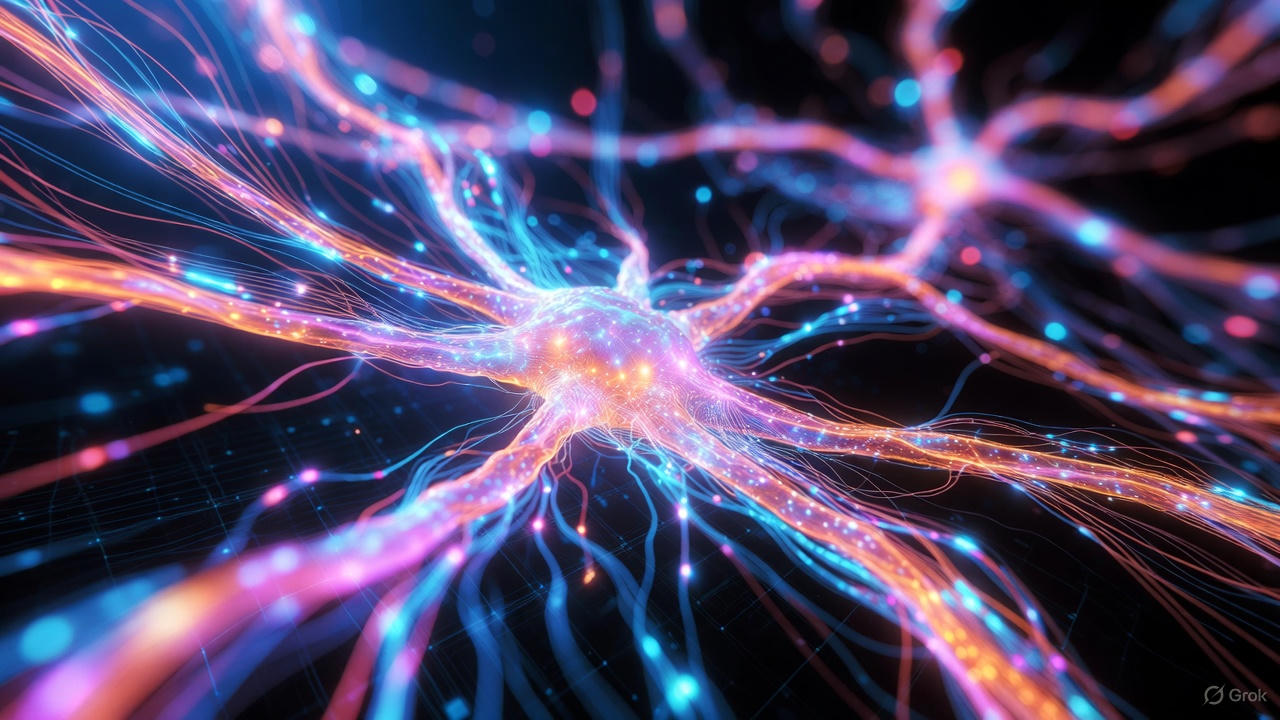The Bedrock of Intelligence: From a Single Neuron to the Heart of an LLM
Peel back the layers of Large Language Models to understand the artificial neuron, the power of ReLU, and how these simple units power the massive Transformer architecture.

At the core of every Large Language Model (LLM), beneath the billions of parameters and the complex Transformer architecture, lies a concept of remarkable simplicity: the artificial neuron. Understanding this fundamental building block is the key to demystifying how neural networks—and by extension, LLMs—actually "think."
What is a Neuron? The Basic Decision-Maker
An artificial neuron is the smallest computational unit of a neural network. Think of it as a tiny, specialized decision-maker. It takes in multiple pieces of evidence (inputs), weighs their importance, and then decides whether to "fire" and pass on a signal.
A neuron has four key components:
Component | Symbol | Description |
|---|---|---|
Inputs | x | Numerical values representing pieces of information. |
Weights | w | Each input is assigned a weight, which signifies its importance. A higher weight means that input has more influence on the neuron's decision. These weights are the primary "knobs" that are "tuned" during the model's training process. |
Bias | b | A single, extra number that acts as an offset. It helps the neuron fire even if all inputs are zero, or conversely, makes it harder to fire. It gives the neuron more flexibility. |
Activation Function | — | After weighing all the inputs and adding the bias, the result is passed through an activation function. This function makes the final "fire" or "don't fire" decision and introduces non-linearity, which is crucial for learning complex patterns. |
A Simple Analogy: Imagine a single neuron whose job is to decide if you should go for a run or not.
Step | Description | Example |
|---|---|---|
Inputs | Binary values for each condition | Is it sunny? (1 for yes, 0 for no)Did you sleep well? (1 for yes, 0 for no)Do you have time? (1 for yes, 0 for no) |
Weights | Importance assigned to each input | sunny: w1 = 0.7 (high)sleep: w2 = 0.5 (medium)time: w3 = 0.2 (low) |
Calculation | Weighted sum of all inputs | (sunny * 0.7) + (sleep * 0.5) + (time * 0.2) |
Activation | Decision based on total score | If score is high enough → "Go for a run!" |
The Importance of ReLU (Rectified Linear Unit)
One of the most common and important activation functions is ReLU. Its rule is incredibly simple:
If the input to it is positive, it passes that value along. If the input is negative, it outputs zero.
f(x) = max(0, x)
Why is this simple function so powerful?
- Simplicity and Speed: It's computationally very cheap, making it fast to calculate.
- Non-Linearity: Despite its simple appearance, it introduces non-linearity. Without this, a neural network, no matter how many layers it has, would just be a simple linear regression model, incapable of learning complex patterns like language. ReLU allows the network to model intricate relationships in data.
- Solves the "Vanishing Gradient" Problem: In deep networks, older activation functions caused signals to shrink to almost zero as they passed through many layers, making it impossible for the network to learn. ReLU's "all or nothing" nature helps maintain a strong signal, allowing for much deeper and more powerful models.
From One Neuron to a Network: The Power of Layers
A single neuron is not very smart. The real power comes from connecting them together in layers to form a neural network.
- Input Layer: This layer simply receives the initial data (like the vector for a word).
- Hidden Layers: These are layers of neurons between the input and output. Each layer takes the outputs from the previous layer as its inputs. This is where the magic happens. The first hidden layer might learn to identify simple patterns (like grammatical parts of speech). The next layer takes these identified patterns and learns to combine them into more complex concepts (like semantic relationships between words).
- Output Layer: This final layer produces the network's result (like the probability of the next word).
Think of it like an assembly line for analysis. The first layer of neurons are generalists, the next are specialists that build on the generalists' work, and so on, until a highly refined and complex decision is made.
Tying it All Back to the Transformer Architecture in LLMs
So, where do these simple neurons fit into a massive 7-billion-parameter LLM? They are the bedrock of the Feed-Forward Network (FFN) sub-layer found inside every single Transformer Block.
Recall that each Transformer Block has two main parts: the attention mechanism and the FFN. That FFN is, at its heart, a simple two-layer neural network.
- The Up-Projection Layer: This is the first hidden layer. It's a wide layer with thousands of neurons (e.g., 11,008 in Llama 7B). It takes the
d_modelvector (e.g., 4096 dimensions) and "projects" it into a much larger space. Each of these 11,008 neurons is a simple decision-maker with its own weights and bias. - The ReLU Activation: The output of this massive layer is then passed through a ReLU activation function.
- The Down-Projection Layer: This is the second hidden layer (which also serves as the output layer of the FFN). It takes the large, activated vector and projects it back down to the original
d_modelsize (4096).
When you hear that an LLM has "billions of parameters," the vast majority of those parameters are the simple weights and biases belonging to the neurons in these FFNs, replicated across every single one of the model's 32 (or more) layers. The immense "knowledge" of an LLM is encoded in the tuned importance (weights) that each of these millions of tiny decision-makers assigns to its inputs.
"Hello World": A Practical Code Snippet
This Python code using NumPy demonstrates a single neuron, a layer of neurons, and a simple two-layer network, mimicking the FFN in a Transformer.
import numpy as np
# Set a random seed for reproducibility
np.random.seed(42)
# --- 1. The ReLU Activation Function ---
# If the input is positive, return it; otherwise, return 0.
def relu(x):
return np.maximum(0, x)
# --- 2. A Single Neuron ---
# A neuron takes inputs, multiplies them by weights, adds a bias,
# and applies an activation function.
class Neuron:
def __init__(self, num_inputs):
# Each input has a weight. The bias is a single value.
self.weights = np.random.rand(num_inputs)
self.bias = np.random.rand(1)
def forward(self, inputs):
# Calculate the weighted sum + bias
total = np.dot(self.weights, inputs) + self.bias
# Apply the activation function
return relu(total)
# --- 3. A Layer of Neurons ---
# A layer is just a collection of neurons that all process the same input.
class Layer:
def __init__(self, num_neurons, num_inputs_per_neuron):
# The layer consists of a list of individual neurons
self.neurons = [Neuron(num_inputs_per_neuron) for _ in range(num_neurons)]
def forward(self, inputs):
# Get the output from each neuron in the layer for the given inputs
return np.array([neuron.forward(inputs) for neuron in self.neurons])
# --- 4. A Simple Two-Layer Neural Network (like an FFN) ---
# This network will mimic the FFN in a Transformer Block.
class SimpleFFN:
def __init__(self, input_size, hidden_size, output_size):
# Up-projection layer (e.g., 4 inputs to 8 neurons)
self.hidden_layer = Layer(num_neurons=hidden_size, num_inputs_per_neuron=input_size)
# Down-projection layer (e.g., 8 inputs to 4 neurons)
self.output_layer = Layer(num_neurons=output_size, num_inputs_per_neuron=hidden_size)
def forward(self, inputs):
# Pass input through the first (hidden) layer
hidden_output = self.hidden_layer.forward(inputs)
print(f" -> Output after Hidden Layer (and ReLU): {hidden_output.flatten()}")
# Pass the result through the second (output) layer
final_output = self.output_layer.forward(hidden_output)
return final_output
# --- Let's run it! ---
print("--- Hello, Neural Network! ---\n")
# Define the dimensions (much smaller than an LLM for demonstration)
INPUT_DIM = 4 # Like a small d_model
HIDDEN_DIM = 8 # Like a small ffn_intermediate_size
OUTPUT_DIM = 4 # Projecting back to d_model
# Create our simple FFN
ffn = SimpleFFN(input_size=INPUT_DIM, hidden_size=HIDDEN_DIM, output_size=OUTPUT_DIM)
# Create a sample input vector (e.g., a simplified word embedding)
input_vector = np.array([-0.5, 2.0, -1.0, 3.5])
print(f"Input Vector: {input_vector}\n")
# Process the input through the network
output_vector = ffn.forward(input_vector)
print(f"\nFinal Output Vector: {output_vector.flatten()}")
Final Thoughts
The gap between a "Hello World" neural network and a cutting-edge LLM is smaller than you think. Both share the same DNA: the artificial neuron.
By mastering the concepts of weights, biases, and layers, you have grasped the bedrock of deep learning. The complexity of an LLM doesn't come from complicated parts, but from the emergent behavior of simple parts working together on a massive scale. You now hold the keys to understanding how machines "think"—one dot product at a time.


